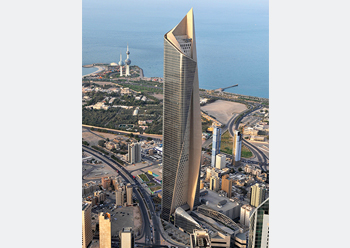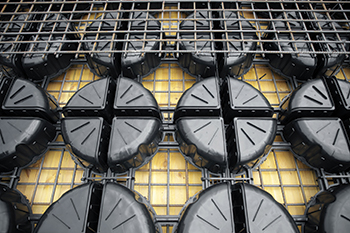
 Cobiax CLS reduces volume of concrete needed by up to 35 per cent.
Cobiax CLS reduces volume of concrete needed by up to 35 per cent.
Heinze Cobiax Deutschland, a market leader in the field of voided-slab systems, unveiled its unique structure-forming lightweight construction elements for reinforced concrete slabs at Bau 2019, a premier trade fair for architecture, materials and systems, held in Munich, Germany, in January.
Cobiax CLS – concrete lightweight structures – is a patented structural former for reinforced concrete slabs that promotes sustainability and builds on previous models that have enjoyed success worldwide.
“The CLS elements differ from previous models, Cobiax Eco-Line (EL) and Cobiax Slim-Line (SL), in having a square footprint, 60 by 60 cm, with a quarter void at each corner,” explains Volkmar Wanninger, managing director of Heinze Cobiax Deutschland.
The individual half parts can be put together in modular form, enabling up to 19 different combinations that allow slab thicknesses from 20 cm to 80 cm plus, extending the existing range by five more sizes.
 |
|
Assima Tower in Kuwait ... using Cobiax SL. |
“When assembled, the CLS elements, which can easily be laid out in a row without gaps, automatically form a stable structural design using voids. At the same time, they guarantee reliable load-bearing ability without using additional steel,” explains Wanninger.
The clever design of this latest development has huge benefits for logistics and assembly, as well as for the environment, he adds.
“Cobiax CLS can be stacked up to save space, so that the room available in a truck can be used efficiently and a larger quantity can be transported. This not only reduces logistical costs, but also fuel consumption,” he says.
Although solid concrete slabs are needed in some areas of the structure to ensure the required load-bearing capacity, up to 80 per cent of the total area can be created with enclosed voids using Cobiax products. The volume of concrete needed can, therefore, be reduced by up to 35 per cent along with some 20 per cent saving in reinforcement steel. As a result, environmentally-harmful carbon dioxide (CO2) emissions have been reduced demonstrably, by up to 20 per cent, according to Wanninger.
“We want to reduce CO2 emissions from reinforced concrete construction by a total of one million tonnes over the next five years using our CLS structural formers, and bring about a rethink in sustainable construction through our products,” explains Dr Karsten Pfeffer, managing director of Heinze Cobiax Deutschland.
As more than 14 million sq m of Cobiax voided flat slabs have already been produced, corresponding to two million tonnes of concrete saved and a CO2 reduction of 180,000 tonnes, this objective seems quite realistic, the German company points out.
“Like all our products, CLS structural formers are made from 100 per cent recycled plastic, and make it possible to use up to 35 per cent less concrete compared with solid slabs. We can boost CO2 reductions even further thanks to the new square design for the CLS structural formers, as these save space during transport,” explains Wanninger.
The eco-friendly and economical technology replaces concrete in slabs with voids, wherever the structural design allows. The areas required for load-bearing are the integral part of the individual structural formers. These can be laid in a row quickly and easily without gaps, so that no time-consuming lining up is needed. Depending on slab construction, they can be used for covering 60 to 80 per cent of the total slab area, Wanninger points out.
A Cobiax slab with CLS structural formers can be designed by any structural engineer, following usual standards with the procedure being similar to existing products, Cobiax Eco-Line and Slim-Line.
Wanninger says the company has already applied for technical approval for the new Cobiax CLS product line, and the required verifications are under way. Heinze Cobiax provides guidance on the most appropriate Cobiax product for the desired slab depth using an innovative tool on its new homepage.
“Speed and easy individual component assembly on site are essential on every construction project,” Wanninger comments. “That’s why we’ve developed our tried-and-tested system further, to reduce overall weight, make assembly easier, and enable even more efficient transport.”
Sustainability is another factor that has influenced the development of the product, which is evidenced through a type III Environmental Product Declaration (EPD), says Pfeffer. “Additionally, the resource and energy-efficient use of materials has been rated positively as part of sustainability certification such as DGNB, Leed (Leadership in Energy and Environmental Design) and Breeam (BRE Environmental Assessment Method), thereby increasing the property value,” he adds.
Cobiax void forming technology – namely the Cobiax SL – is being used in the construction of the Assima Tower, part of the Assima Project, the largest commercial building complex in Kuwait City with over 380,000 sq m of usable space. The impressive skyscraper has over 65 storeys above ground, three basement levels and rises up to an overall height of 301.6 m.
“The original plan included solid, 60 cm ribbed slabs; but serious problems were encountered in the implementation. The owner of the building also wanted high ceilings. In addition, it was a need to speed up the building process,” says a spokesman for Cobiax.
The depth of the slabs could be reduced considerably, thanks to the use of the Cobiax technology. Whereas the initial construction planning was based on 60 cm ribbed slabs, with Cobiax this could be reduced to 40 cm.The slimmer slab construction of the Cobiax SL also fulfilled the owner’s wish for higher ceilings on the individual floors, he adds.
The switch to Cobiax technologies also added value due to a reduced time for construction and also due to reduced construction height of the slabs.
Heinze Cobiax Deutschland has been part of the Heinze Gruppe since 2016 – a consortium of leading companies in plastics engineering. It develops and markets internationally-patented voided-slab systems made from recycled plastic, which can replace up to 35 per cent of the concrete needed in a reinforced concrete slab.





















_0001.jpg)


.jpg)
















.jpg)








.jpg)


